We have some more new project sheets
Lawn Bowl Box
Guilio’s Burl Top Box
Decorative Insert Box
Spoon Box
We have some more new project sheets
Lawn Bowl Box
Guilio’s Burl Top Box
Decorative Insert Box
Spoon Box
Club Meeting:26 Feb 2020
Report by: Murray Wilton
Colin opened his demo by displaying a range of lidded “boxes” he has made over the years. There was a set of 7 boxes, each one smaller than the next so they could be stacked to fit into the next largest box. Like Russian dolls. Apparently the world record for the number of boxes that can be made to stack in this way is 33. Terry has managed to get up to 17. Can anyone meet the challenge and beat that? The walls have to be so thin that turning must be done carefully with accurate measurements. Colin made his septet of boxes early in his turning career. He also revealed a sample of the finished product he was aiming to turn this evening and showed off a square box beautifully made from laminated timbers.
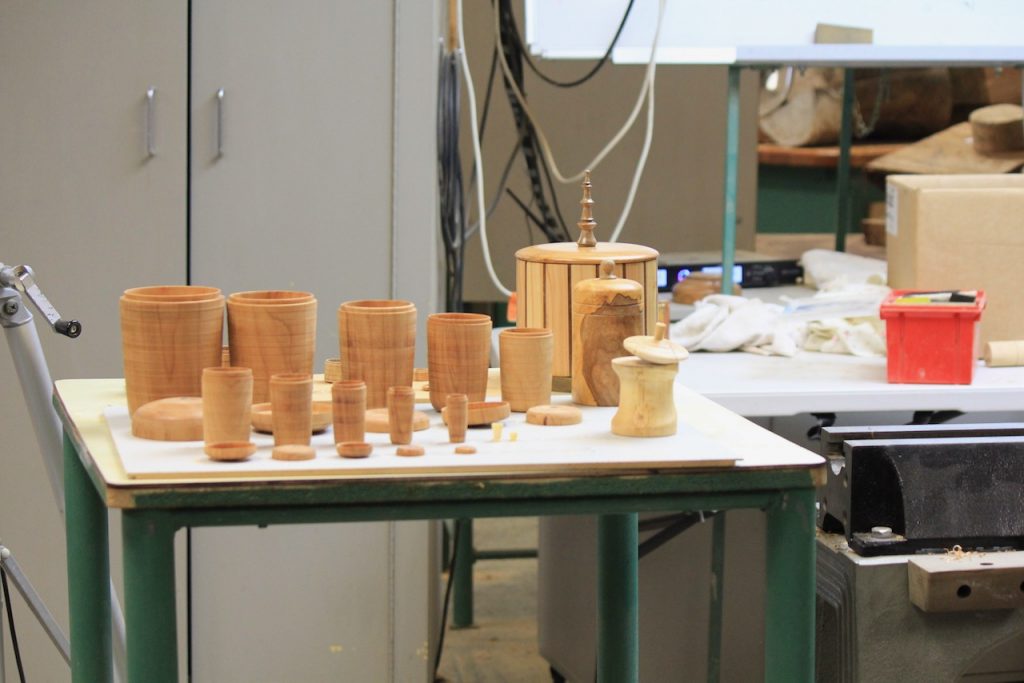
Colin’s demo started with a block of bird’s-eye pine, about 60 mm square and 180 mm long. He had previously rounded off the block and cut an off-set spigot in one end about 6mm from the true centre of the box, with the equivalent marking at the other end for holding with a steb centre at the tailstock end. With the block held by the offset spigot, he drilled a hole with a 32 mm Forstner bit, drilling slowly to avoid burning and ensuring the depth was sufficient to leave a box bottom about 5 to 8 mm thick. Drilling avoids having to do any hollowing.
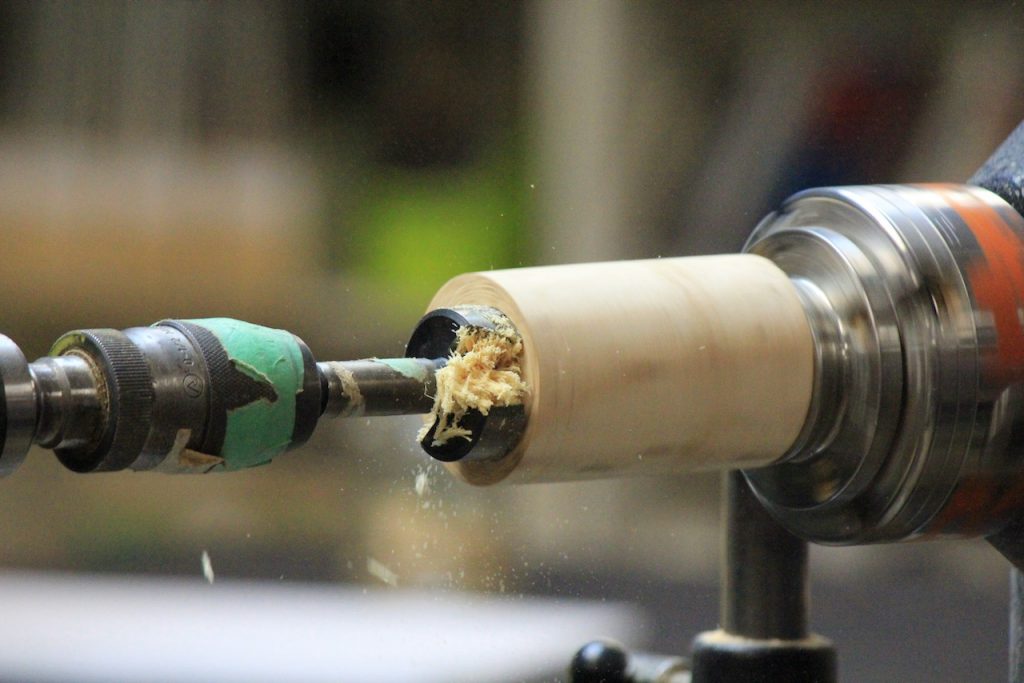
[HANDY TIP No. 1: Colin uses boelube on the drill to keep it moving and avoid burning. Always drill slowly with Forstner bits and frequently extract from the hole to clear shavings.]
Once the desired depth is reached Colin marked that level on the outside so later he would know where to part off the lid of the box. He also marked the position of the curves he wanted to apply to the box. Next the box is de-mounted and a plug inserted in the hollow (top) ready for shaping and to give the box its unique (but not altogether beautiful) off-set shape. Now the block is re-mounted in the off-set spigot with the steb centre holding the off-centre mark at the tailstock end marked in the plug. The shaping must be done carefully with frequent checks to ensure the cuts are not encroaching on the 32 mm hole. If this happens the box will become a sieve.
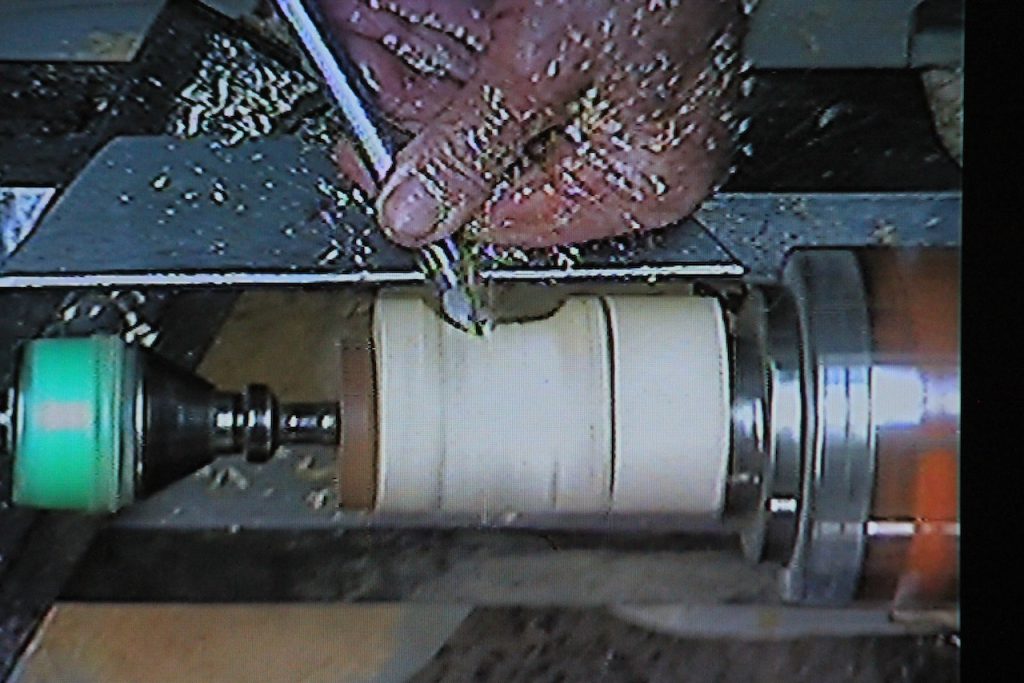
[HANDY TIP No. 2: Off-set turning can be hazardous if anything goes wrong, so make sure you wear the full face guard and keep fingers clear of the unevenly spinning work piece.]
The box is demounted again and mounted in the real centre ready for parting off the lid. Before completing the cut, turn the rebate in the top of the box ready to take the lid. Also do any finishing work needed at this stage because once the lid is parted off it won’t be possible to do this.
After parting off the lid Colin completed shaping it to the desired form and cut the rebate to fit the box opening.
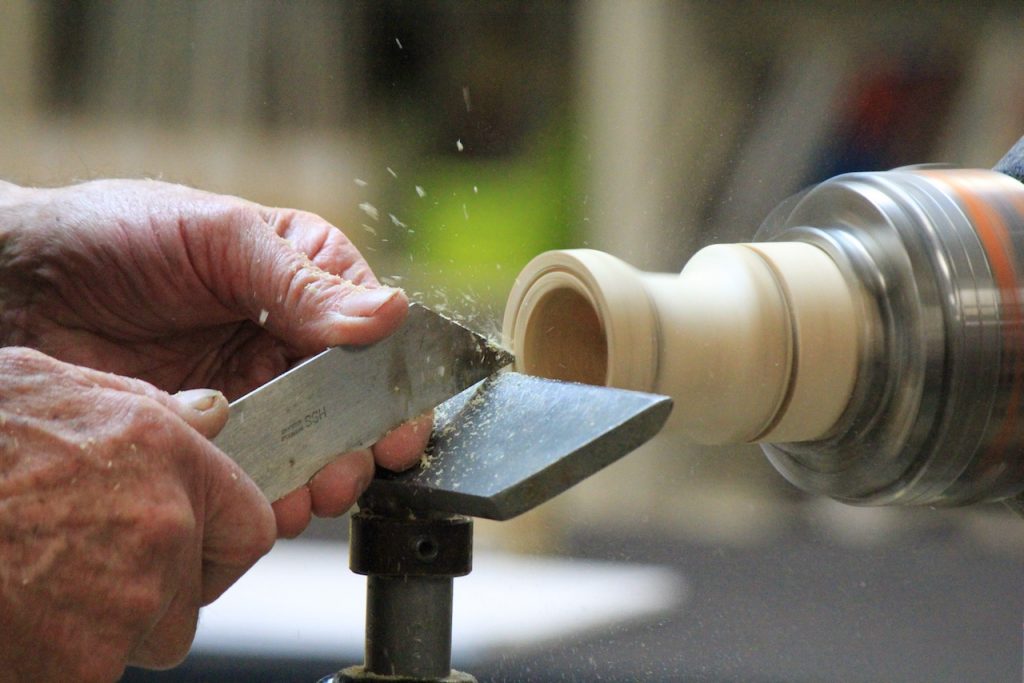
[HANDY TIP No. 3: When turning shapes, rebates, etc., to fit other shapes and rebates, keep checking for a good fit as you go along. Very easy to take off too much and lose a tight fit.]
Colin shaped the lid as a spinning top with a short handle to enable the top to be spun in a small notch cut in the bottom of the box. To do this he first shaped the bottom of the top (meaning the spinning-top), then turned it round in the chuck to finish the “top” of the top! If you get my meaning.
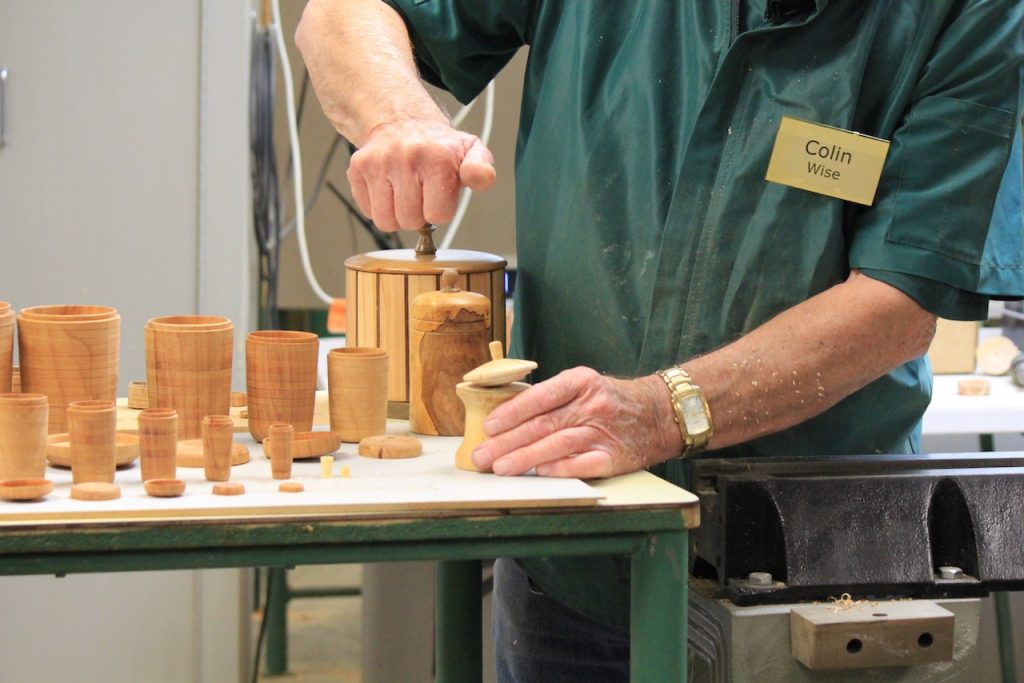
Great demo from another of our turning gurus. Many thanks Colin.
— Written up by “Club’s Most Consistent Volunteer Reporter” Murray Wilton
Club Meeting: Wednesday 19th February
Report by: Emma James-Ries
This week we were treated to a demo by the one and only Dick Veitch. He started off by talking about the latest Teknatool Nova Orion lathe, kindly loaned by Carba-Tec. Dick was very impressed with this version, asides from the secret Tailstock compartment which held centres. Otherwise, if you’re looking to upgrade your lathe, this model won’t disappoint.
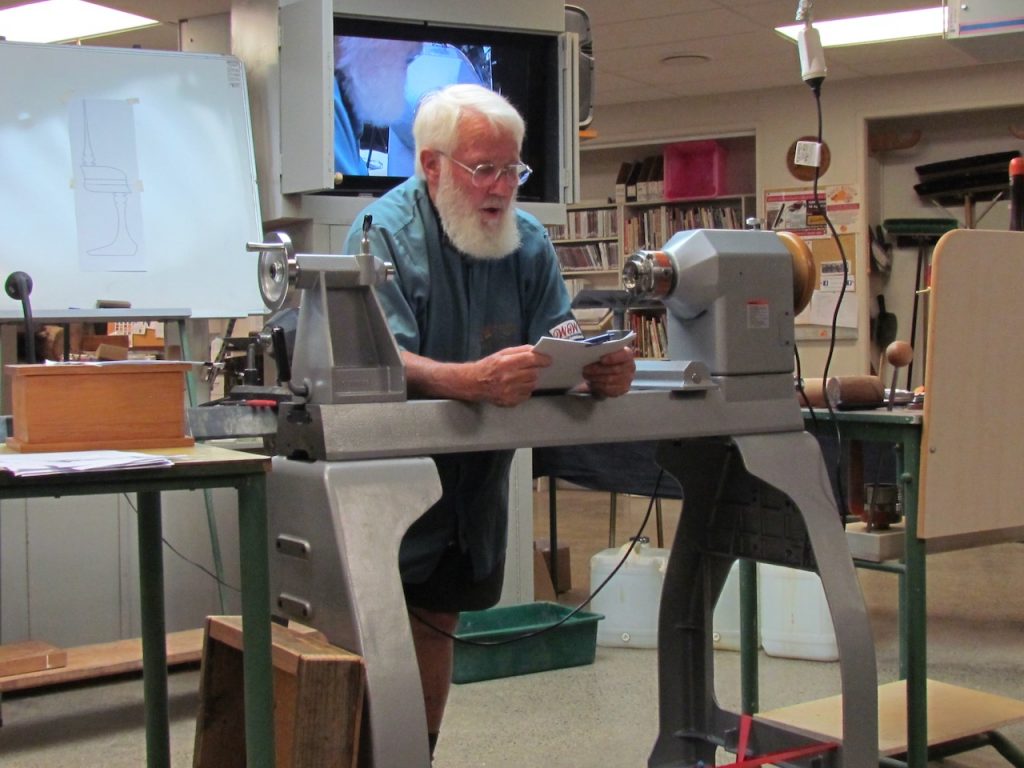
Moving on to the nights project, Dick chose to turn a Spire Box, which was made with multi-centres. It is import to choose a strong grained wood for this project. Taking a piece of wood with dimensions 220mm long and 70mm square, mount on the lathe and round off to 60mm diameter. Once round, cut the curve of the outside of the foot of the box. Then cut a cove in the centre down to 51mm. Now part this cove down the middle and set the spire part aside. Dick then went on to hollow out the lid part of the top section of box. Setting that aside, he hollowed the bottom part of the box to fit the lid. It was at this point that Dick realised he needed to stand on a platform to properly hollow the box, as the new lathe was fractionally too high (it was on a small plinth). Always important to remember to be at the right height for turning to avoid unnecessary strains and pains.
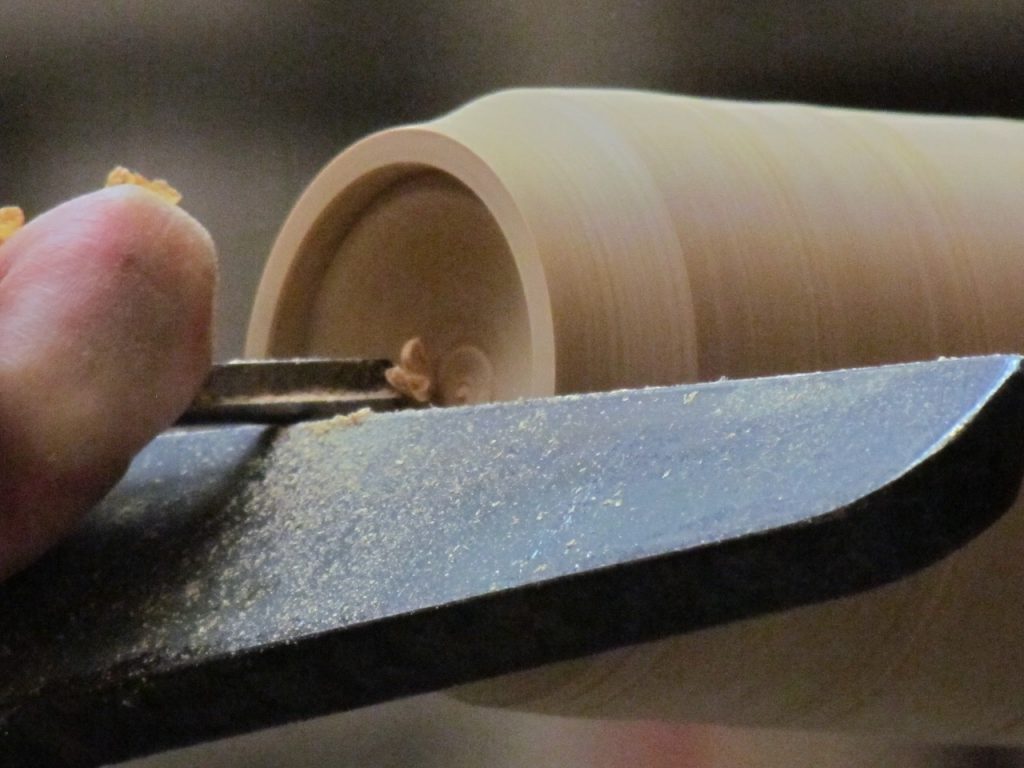
After that was complete, he put both parts of the box together and remounted on the lathe, to recut the curve in the centre. Once cut down to 48mm, mark the centre points on each end. Dick then went on to explain that while making this project, he encountered problems when turning the shaft of the base and the finial on top. This was because the off set body of the box was too heavy for the shaft to bare once it was turned thin. To counteract this problem, Dick made a jam block that fitted neatly into the box to reduce the off-centre weight. Once counterweighted, go on to shape the stem with a spindle gouge. Dick made some lovely beads and wings under the box body and tapered the stem. He then showed us a clever way of sanding the underneath of the box with an electro file. Dick mentioned at this point, that it was wise to put a brace between the box and for to steady the stem when sanding as it is so fragile at this point.
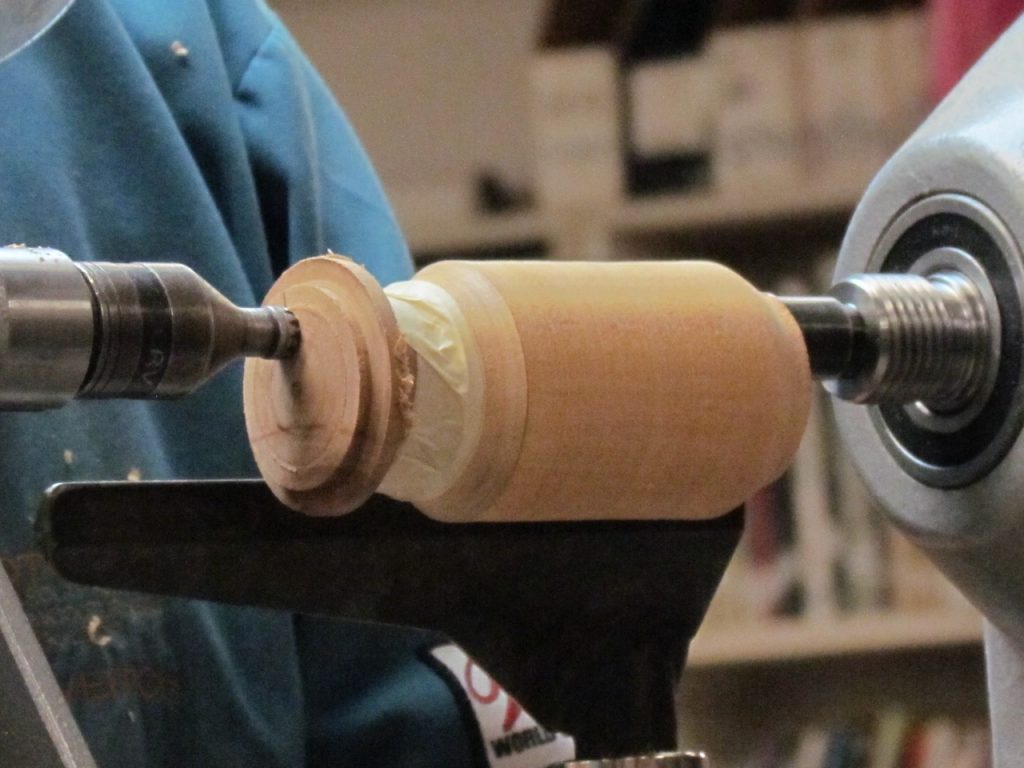
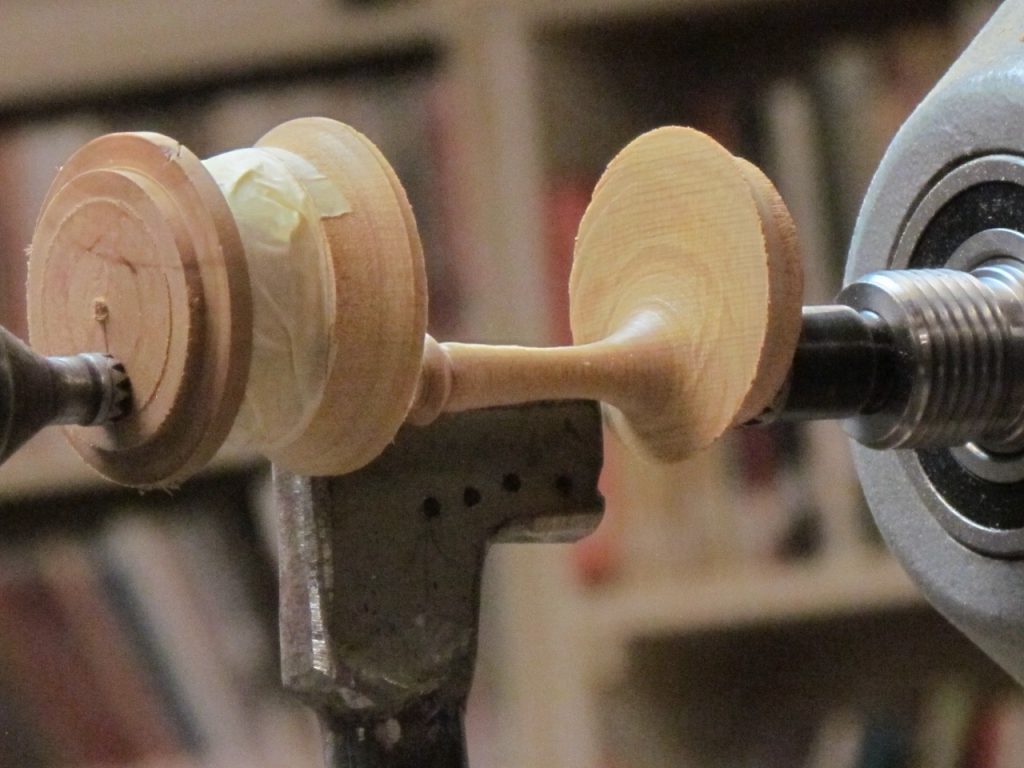
Once Dick was done sanding the base, he went over to his special ‘magic box’ and pulled out one he’d made earlier. A fabulous project, thank you very much. This project sheet is available on the SAWG website under the name Spire Box.
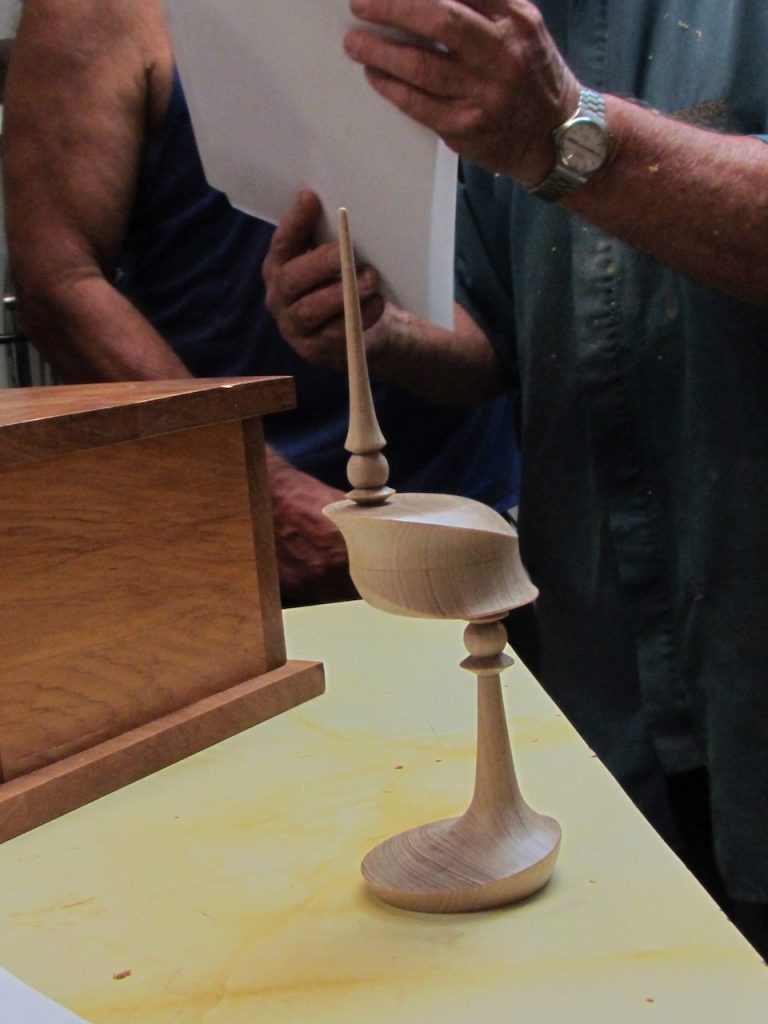
Club Night: 12 Feb 2020
Report by: John Whitmore
Cam Cosford treated us to a demonstration of box making with a difference. The shape was of triangular footprint but having convex (not straight) sides. The complexities of this were somewhat baffling to many and way beyond the scope of this report to record in detail, but there were some take home messages that are worth recording for posterity:
The project was made from a blank of 150 mm dia and 80 mm long – which gives a good idea of the overall size. This can be scaled either way for personal preference.
When removing and replacing a project on a 4 jaw chuck in compression mode, mark the work opposite a known jaw number so that the item is remounted exactly as it was first positioned, using the original pressure marks. This facilitates consistently true running.
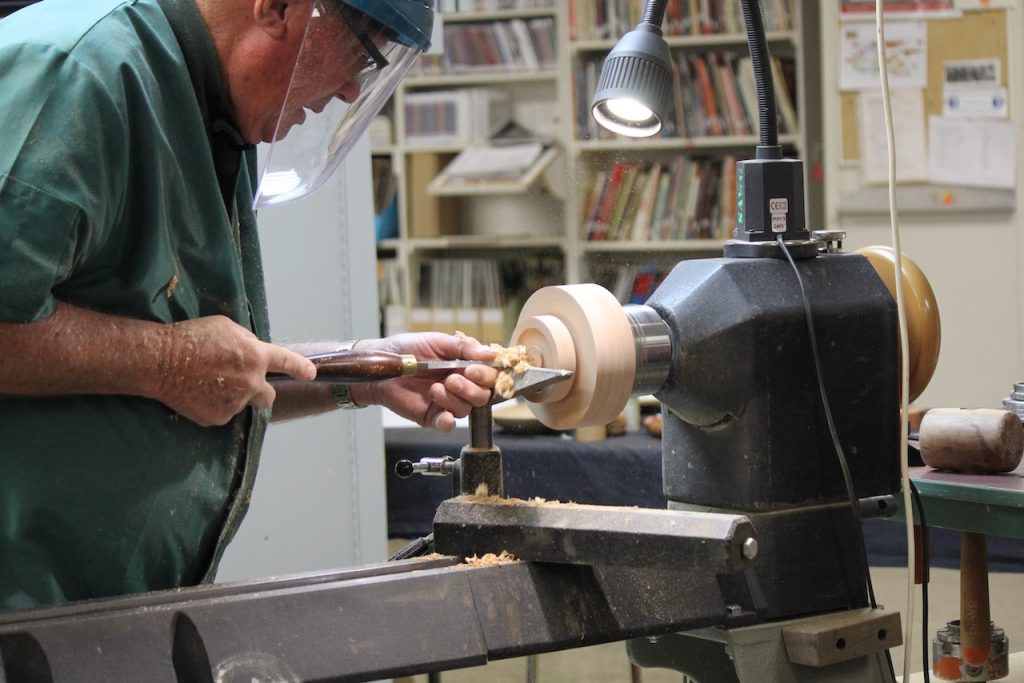
Parting off a box lid is best started using the thinnest parting tool available and completed by hand saw with the work stationary. A thin parting tool enables grain to be better matched between box and lid.
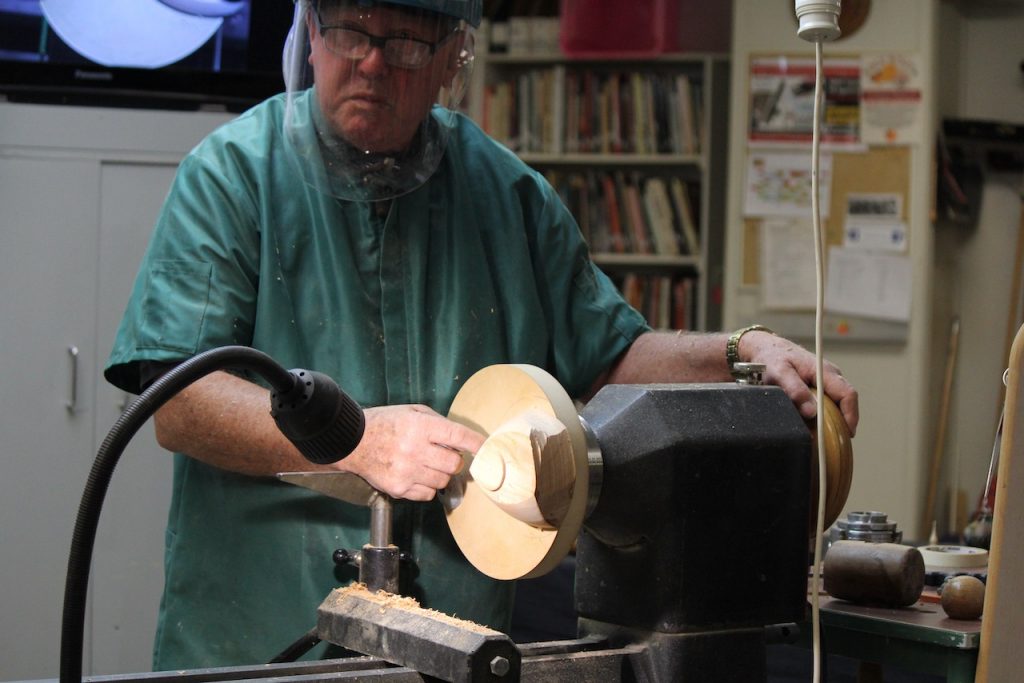
Marking out the design intentions involves careful geometric drawing. To create a triangle out of the original circular disc requires offset turning and a great deal of hit-and-miss cutting. Off-setting is by means of a custom faceplate made from 30 mm mdf and necessitates very accurate (again, of geometric quality) laying out of positioning marks. Securing of the work to the offset faceplate is assisted by means of a screw into the workpiece centre to allow rotation between the three cutting centres and blobs of hotmelt glue for security at each stop. A counterbalance weight is essential.
The feet were cunningly made by utilising the original flat base of the blank as their resting surfaces and shaping the sides via the process of creating the convex triangular curves. Unusually, the underside was deeply dished between the feet with the effect of letting light underneath to create lift of the box and visual separation of the feet.
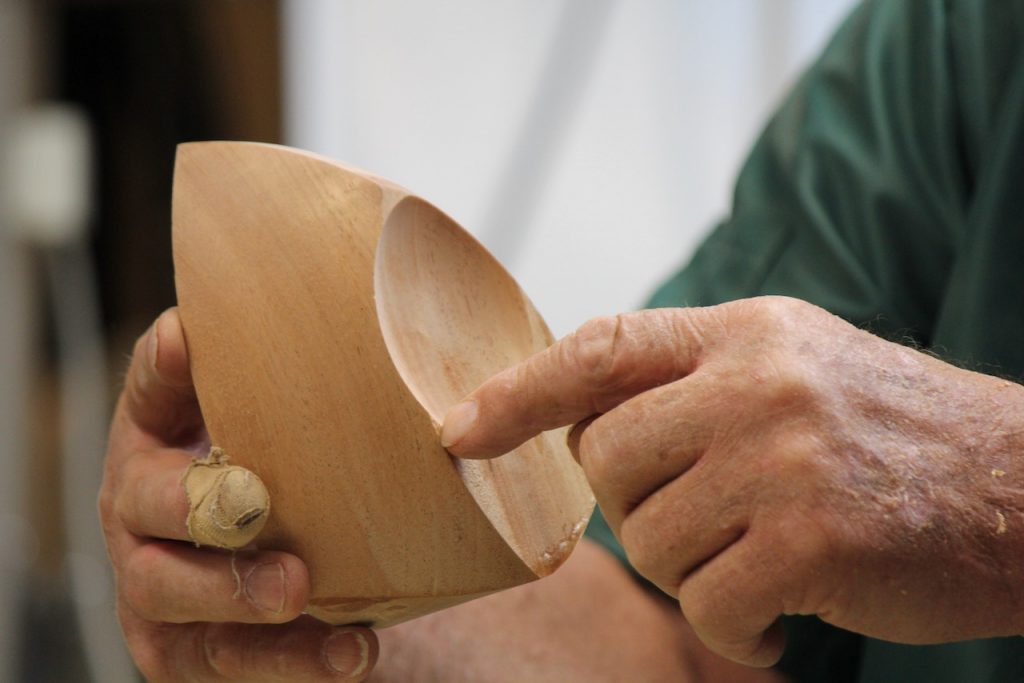
The likelihood is that this will be written up as a project plan for our website so greater detail is expected in due course along with drawings to illustrate the finer points. This project does flag the benefits of precision planning and that there are endless permutations in woodturning to be explored and experimented with.
Club Night: 5 Feb 2020
Report: Bob Yandell/Strett Nicolson
Material
Grain can enhance the result.
Plain straight grain needs to be given a lift just as too much figure has its own difficulties. Material of choice Macrocarpa as it is stable and grain lends itself to natural wood colour or dyes.
90 x 90 x 110mm, ideally has faces at right angles.
1. Square off ends and turn a 48mm x 10mm spigot on both ends and take off square edges thus reducing chance of splintering off and cuts i.e. just a radius.
2. Lock and mark middle point between spigots and decide which will be the lid and which will be the box based on grain and mark accordingly.
3. Cut through using the Bandsaw. You now have 2 pieces
a. The Lid
b. The Box
Mount the Box in the 50mm chuck and square off face.
1. The rough shape of the base of the apple the curve begins about 20% down from the squared off face and end at the spigot.
2. Cut the tenon approximately 4mm in from the outside edge using the Parting Tool to a depth of 6mm approx. Start the internal wall so overall thickness is roughly 10mm.
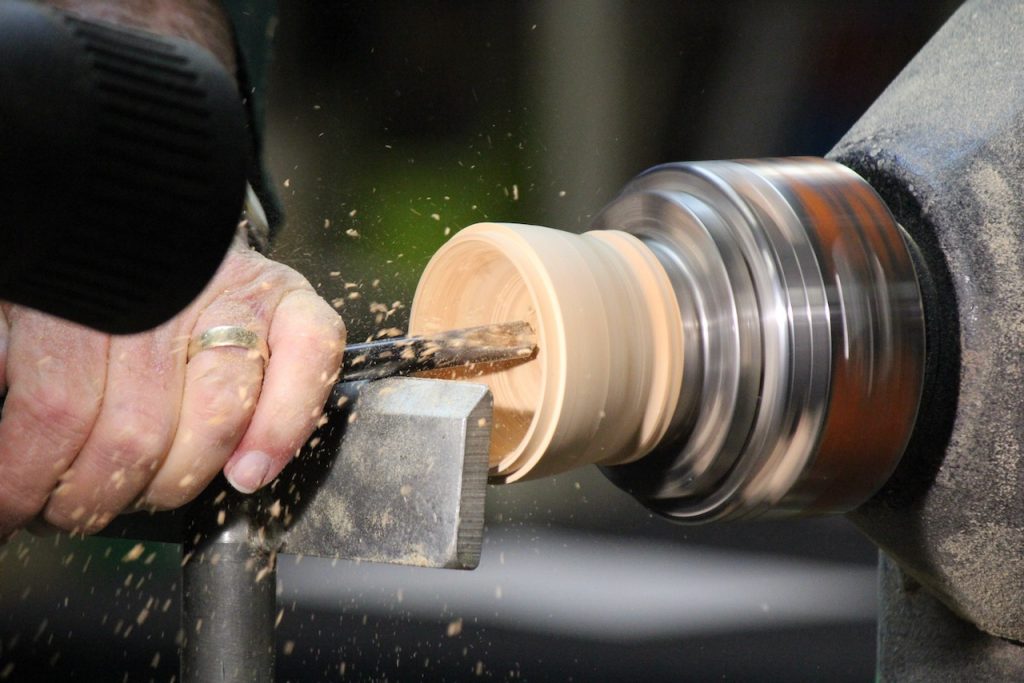
3. Hollow out using 10mm Bowl Gouges (35 and 55), Hollowing Tools and Scrappers assist. Check the depth, you must not go into the spigot. Sand and finish inside and apply sanding sealer.
Mount the Lid in the 50mm chuck and square off face.
1. The rough shape of the top of the apple the curve begins about 20% down from the squared off face and end at the spigot.
2. Mark the size of the diameter of the tenon using dividers.
3. Carefully cut the mortise to a depth of approximately 4mm using the Parting Tool to a depth that will allow you to check the box fit(Tenon is 6mm). Check fit often. Not too tight – you cannot put wood back. Start the internal wall so overall thickness is roughly 10mm
4. Hollow out using 10mm Bowl Gouges (35 and 55), Hollowing Tools and Scrappers assist. Sand inside and apply sanding sealer.
Mount the Box in the 50mm chuck using expansion mode
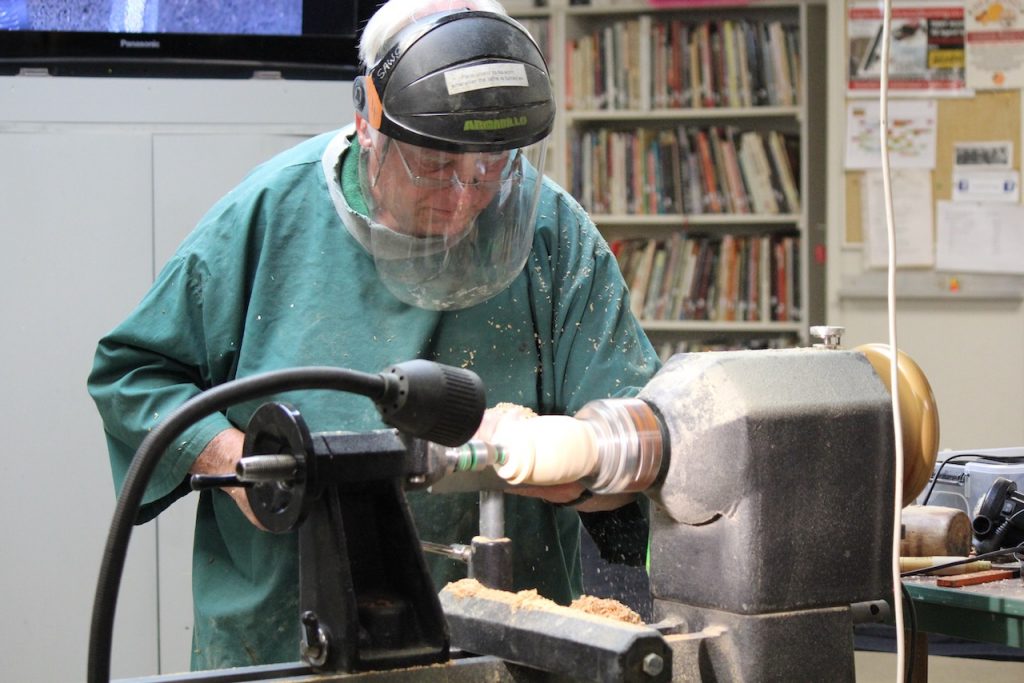
1. The rough shape of the base of the apple the curve begins about 20% down from the squared off face down removing the spigot to an acceptable diameter for the base of the fruit(40mm) then turn in to create the hollow at the base of a fruit.
2. Sand and finish
Mount the Lid in the 50mm chuck and square off face.

1. The rough shape of the top of the apple the curve begins about 20% down from the squared off face down removing the spigot to an acceptable diameter for the top of the fruit(50mm) then turn in to create the hollow but leave a 5mm spigot to create the stalk of a fruit. You can use an actual stalk.
2. Shape stalk, sand and finish.

Write up: Holm Miehlbradt
Club Meeting: 30 Jan 2020
Tonight Bruce demonstrated how to make a lidded box out of an old lawn bowls.
The first “obvious” advice was to make sure that the bowl is made of wood rather than a plastic one!
To initially mount the bowl, one of the existing rings (after cleaning it out) is used with a fitting chuck and with a padded jig on the tailstock. A spigot is the turned and the diameter is reduced/shaped on the tailstock side. This will be the bottom of the box.
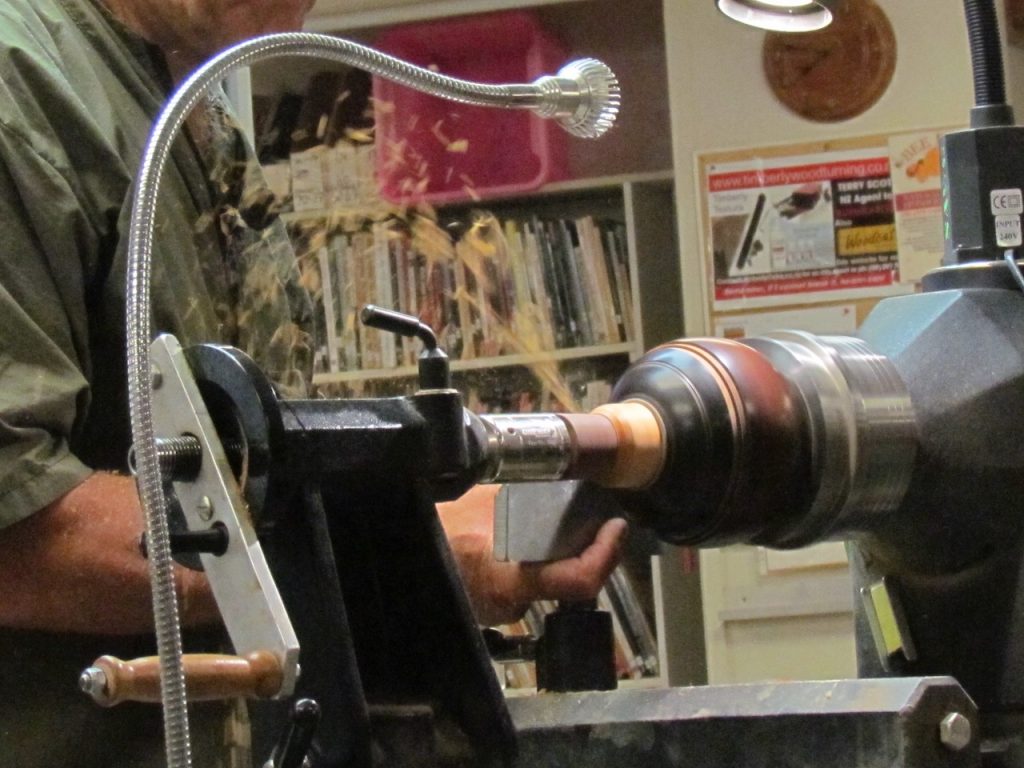
The bowl is then mounted with the spigot. The outside of the lid is then shaped and while parting it off a tenon is formed.
Starting with a Forstner bit, the box is hollowed out partly. The lid is then fitted onto the box and once the connection is shaped it is finished (including sanding, sealing, wax, lacquer, etc.). At this point, Bruce showed how effectively oil-sand which eliminated dust and keeps the sanding paper unclogged for longer.
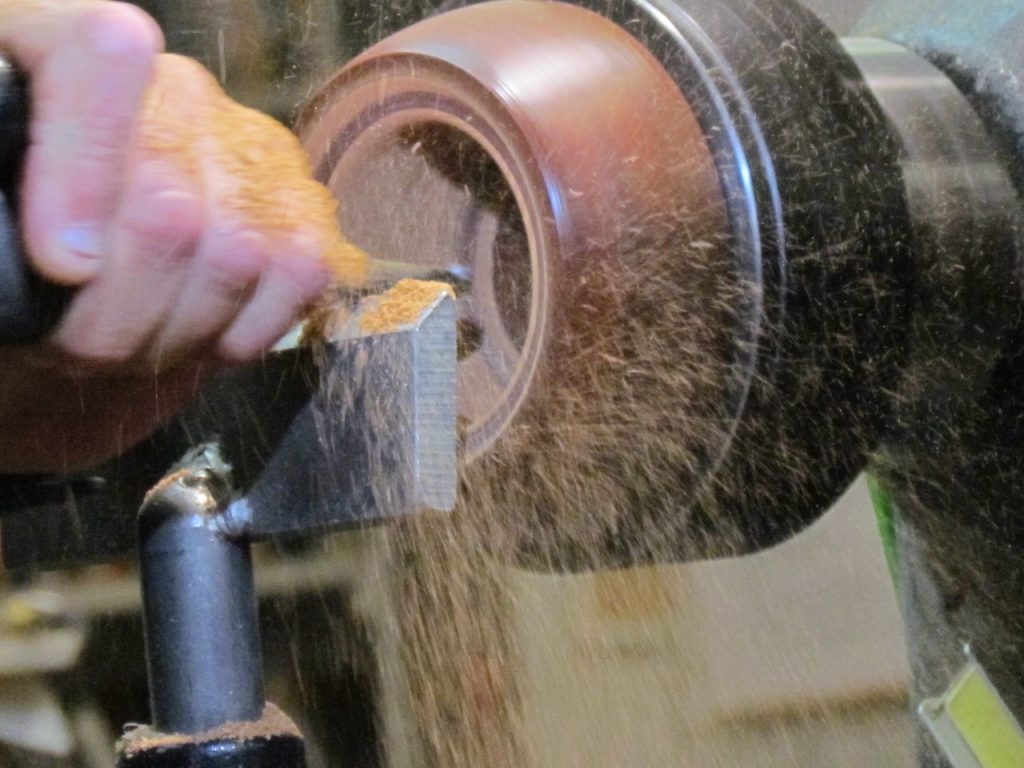
The box is then fully hollowed out and finished.
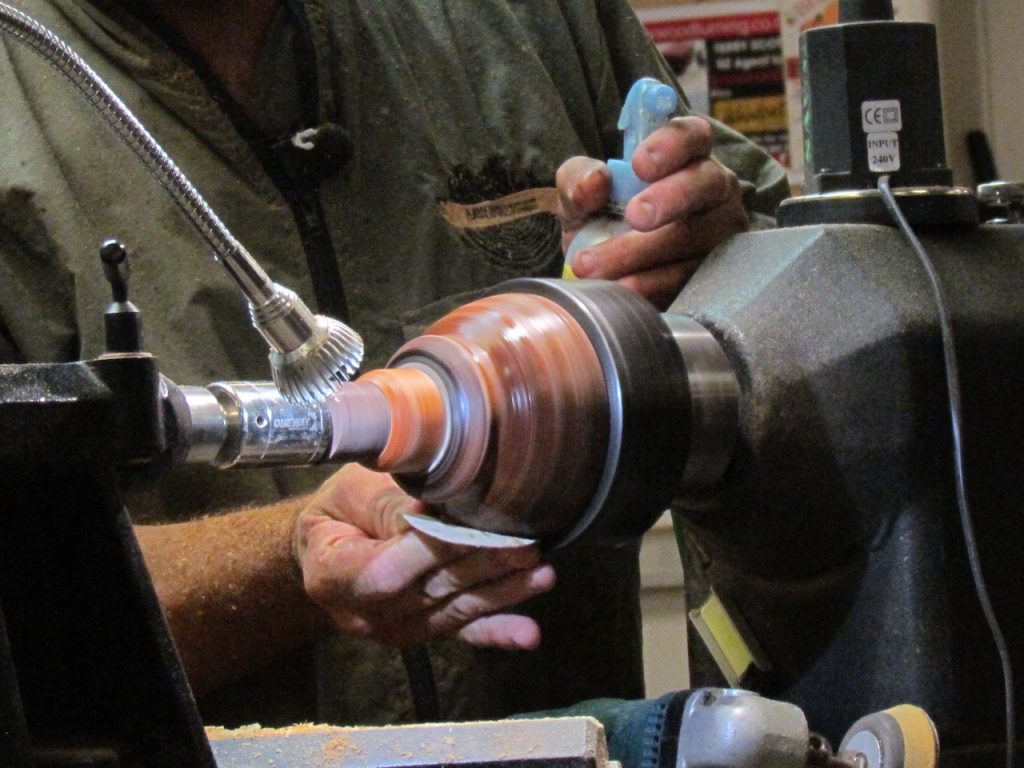
The box is then turned around and the bottom is shaped and finished. With sufficient care some of the original features and decorations of the bowl can be kept near the base to enhance the box.
Finally the lid is mounted (while protected with tape) and the inside of it is finished.
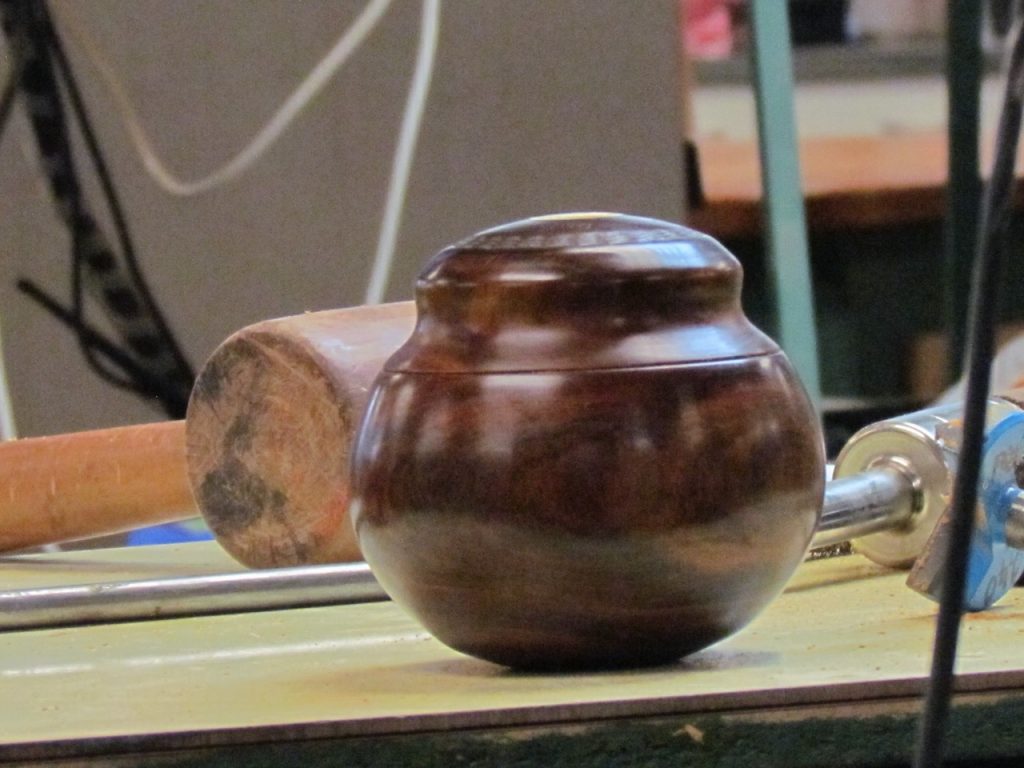
Thanks Bruce for the entertaining demo and the advice which can be used in any turning project.
Additions to our library of project sheets thanks to Dick Veitch for these.
Jewellery Chuck Central
Simple Box
Tea Caddy
Pot for Pyrography
Rings for Decorating
There have been a couple of new project sheets added